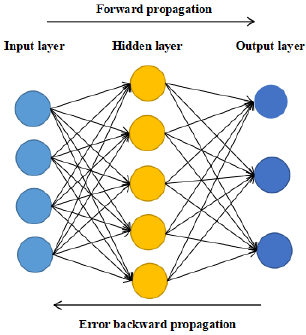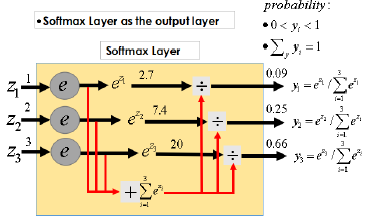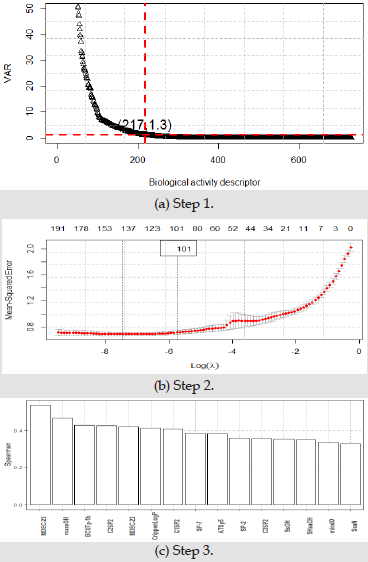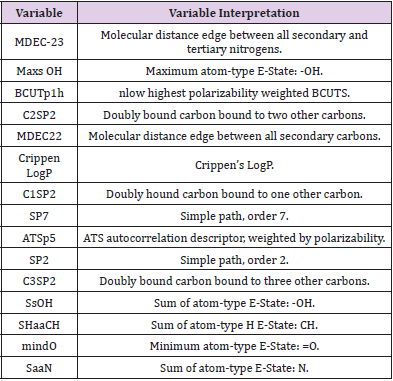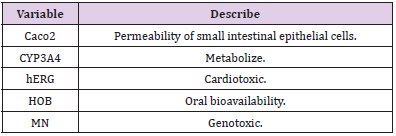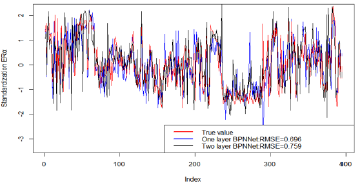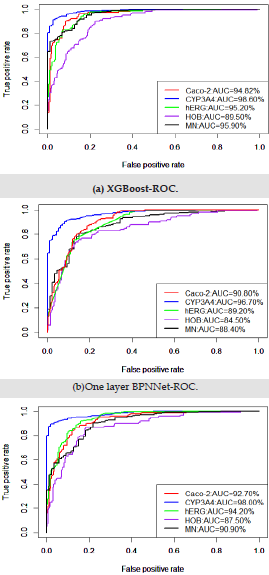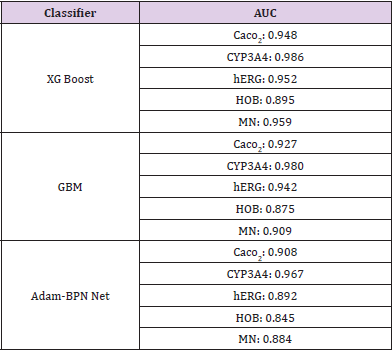Abstract
Breast cancer is one of the most lethal cancers, estrogen receptor α Subtype (ERα) is an important target. The compounds that able to fight ERα active may be candidates for treatment of breast cancer. According to ERα activity, pharmacokinetic properties and safety of the compounds identified 15 biological activity descriptors. In this paper, 15 biological activity descriptors were verified according to the gradient optimization algorithm based on neural network. The research shows that these 15 biological activity descriptors can not only predict ERα with low error, can also predict the pharmacokinetic properties and safety with an accuracy more than 90%. Therefore, these biological activity descriptors have great medical research value.
Keywords: Breast Cancer; Softmax Function; Adam algorithm; Biological Activity
Introduction
Breast cancer is one of the most common malignant tumors in women, and a malignant tumor occurring in ductal epithelium of the breast. Estrogen is involved in the growth and differentiation of mammary epithelial cells in hormone dependent tumors. It plays an important role in the occurrence and development of breast cancer [1]. Estrogen mainly acts through the estrogen receptor expressed in the nucleus, that is, by binding with estrogen receptor (ER) to form a complex [2]. Research shows that ERα is expressed in normal breast epithelial cells less than 10% but expressed in breast cancer cells around 50%-80%. ERα has become an important target of endocrine therapy for breast cancer [3]. Currently, antihormone therapy is commonly used in breast cancer patients with ERα expression, which controls estrogen levels through regulating estrogen receptor activity. ERα mediates the E2 up regulation of PI3K/Akt signaling pathway and promotes cell proliferation [4]. Compounds that can antagonize ERα activity may be candidates for treatment of breast cancer. For example, tamoxifen and renoxifene are the ERα antagonists for clinical treatment of breast cancer [5]. In order to screen potential active compounds, a potential compound model is usually established to collect compounds and bioactive data by targeting the specific estrogen receptor subtype targets associated with breast cancer. The quantitative structureactivity relationship (QSAR) model of compounds was constructed with the biological activity descriptor as the independent variable and the biological activity of compounds as the dependent variable. The model was used to predict the new compound molecules with good biological activity or guide the structural optimization of existing active compounds. A compound that wants to become a candidate drug, besides having good biological activity (here refers to anti breast cancer activity), also needs to have good pharmacokinetics and safety in human body. It is called ADMET property, including absorption, distribution, metabolism, excretion and toxicity. When determining the biological activity of a compound, it is also necessary to consider its ADMET properties as a comprehensive consideration. In this paper, the coupling degree between bioactivity descriptor and ER activity is verified by BP neural network. After determining that the screened bioactivity descriptors can indeed affect ERα activity to a great extent, the ADMET property of bioactivity descriptors is further verified.
Overview of BP Neural Network
Artificial neural network is widely used in pattern recognition, function approximation and so on. BP neural network is a multilayer feedforward network simulating human brain. It has good adaptability and training ability, belongs to nonlinear dynamic system, and including two processes: forward propagation of information and back propagation of error. BP neural network consists of three parts: input layer, hidden layer and output layer. The input layer receives the input information, and then transmits the information to the hidden layer. The hidden layer analyzes and processes the data. Finally outputs acceptable information through the output layer. This information is continuously corrected through the reverse propagation of error, which can make full use of the coupling between data. BP neural network shows excellent accuracy in many fields. Therefore, this paper selects neural network as the main prediction method. Whether it is regression network or prediction network, the setting of the hidden layer and the number of hidden nodes of the network is very important. Too few hidden layers and hidden nodes will lead to less data information that the neural network can process, resulting in low prediction accuracy, and too many hidden layers will lead to overfitting of the model. There is no general calculation formula for the setting of the optimal number of hidden nodes. It is more based on the empirical formula or changing the number of hidden nodes to continuously train the model to find the number of hidden nodes with the smallest error [6-8]. Basic structure diagram of BP neural network is shown in Figure 1. The activation function of BP neural network usually uses softmax function to give corresponding weight to each node and transfer information between nodes in the network. In addition, there is an offset weight in the propagation of each layer of network, which is an additional constant of SoftMax function. In the model training, the gradient optimization algorithm (Adam algorithm) is used to optimize the model to obtain the best results [9].

Its operating principle is shown in Figure 2.
Adam Algorithm:
Initialize 1st, 2nd moment vector and timestep:

do while:

Computing the gradient:

Update biased first moment estimate:

Update biased second moment estimate:

Compute bias-corrected first moment estimate:

Compute bias-corrected second moment estimate:

Update parameters:

Where α is the step length, β ;β ε [0,1] is the momen
estimation of exponential decay rate, and f(θ) is the random
objective function of parameter θ. Adam algorithm will be used to
optimize the parameters of BP neural network in order to accelerate
convergence and improve accuracy. The model is:
• Step 1: Initialize the network weight and bias, give each
network connection weight a small random number, and each
neuron with a bias will also be initialized to a random number.
• Step 2: Forward propagation. Input a training sample, and
then calculate the output of each neuron. The calculation
method of each neuron is the same, which is obtained by the
linear combination of its inputs.
• Step 3: The gradient descent method is used to calculate the
error and carry out back propagation. The weight gradient
of each layer is equal to the input of the connection of the
previous layer multiplied by the weight of the layer and the
reverse output of the connection of the next layer.
• Step 4: The weight gradient in the third step is used to adjust
the network weight and neural network bias.
• Step 5: Back propagation, Adam algorithm is used to
accelerate the weight adjustment, initialize the moment
vector and exponential weighted infinite norm to 0, update
the parameters through vector operation, and iterate in t time
from step size to 1. Sort errors and return.
• Step 6: At the end of judgment, for each sample, judge if the
error is less than the threshold set by us or has reached the
number of iterations. We’ll finish training, otherwise, return
step 2.
Data Description and Preprocessing
In this paper, the bioactivity description data set is used to
verify the ERα activity and ADMET properties respectively. The
description dataset contains 729 biological activity descriptors
of 1974 compounds. Because the data dimension is too large and
contains a large number of repetitions and useless variables, this
paper selects 15 most representative biological activity descriptors
from the 729 biological activity descriptors of 1974 compounds.
Firstly, low variance filtering is used to delete the biological activity
descriptors with low information, then considering the correlation
and independence between variables, Lasso regression is used to
select these variables, and finally considering the coupling degree
between variables and ERα activity. The final 15 most representative
biological activity descriptors are obtained. The specific steps are
as follows:
• Step 1: Because the variance of variable can reflect the
degree of dispersion, the variable with small variance contains little
information, which cannot provide key and useful information for
the construction of the model. Therefore, for 729 biological activity
descriptors of 1974 compounds, the variance of 729 variables is
calculated and arranged from large to small.
• Step 2: After cleaning the biological activity descriptors
with low information or no information, use the remaining
molecular descriptors to further process the repeated information
of the data, so as to make the data relatively independent. In this
paper, Lasso feature selection method is used to propose a variable
from two variables with strong correlation to eliminate duplicate
information. The essence of lasso feature selection method is to seek
the sparse expression of the model and compress the coefficients of
some features to 0, so as to achieve the purpose of feature selection.
The parameter estimation of lasso feature selection method is as
follows:

λ is a nonnegative regular parameter, which represents the
complexity of the model. The greater its value, the greater the
penalty of the linear model, λ Determined by cross validation.
• Step 3: Spearman rank correlation coefficient is a
nonparametric index to measure the dependence of two variables,
which can reflect the coupling degree between variables. This
paper uses Spearman rank correlation coefficient to obtain the final
15 representative biological activity descriptors.
Three screening processes by Figure 3 shows, in step 1, 217
biological activity descriptors with variance greater than 1.3 were
left. In step 2, 101 bioactivity descriptors were retained by lasso
feature selection. In step 3, 101 biological activity descriptors are
sorted according to Spearman rank correlation coefficient, leaving
the most representative 15 biological activity descriptors. The
final screening results are shown in Table 1. ADMET properties are
composed of five aspects: absorption, distribution, metabolism,
excretion and toxicity. The corresponding values are provided in
the form of two classifications, ‘1’ represents good or yes, and ‘0’
represents poor or no. Comparison table of ADMET properties are
shown in Table 2.
Model Training and Prediction
In order to avoid over fitting and improve the generalization ability of the model [10], we cut the remaining 15 bioactivity descriptors into 80% of the training set and 20% of the test set. Considering the coupling and the nonlinear relationship between the data, the neural network is used for training and prediction, the training set is used to set the model parameters, and the test set is used to calculate the default accuracy and verify the rationality of the model. When training the model, we should also consider the convergence speed of the model. Neural network is a complex structure with large amount of calculation. When there are too many input variables in the input layer and the amount of data is too large, gradient optimization algorithm is usually used to accelerate the convergence speed of neural network. Adam algorithm is used for model optimization in this paper. The results are as follows:
As can be seen from Figure 4, The red line is the logarithm of ERα, the blue line is the regression prediction result of neural network with one hidden layer, and the black line is the regression prediction result of neural network with two hidden layers. Among them, when the hidden layer is 1, the mean square error of prediction is 0.696, and when the hidden layer is 2, the mean square error of prediction is 0.759.Obviously, when the hidden layer is 1, the regression prediction result is more accurate, and the good prediction accuracy shows that the ERα activity can be controlled by controlling the 15 biological activity descriptors selected in this paper, so that we can inhibit the ERα activity. In order to ensure that the selected bioactivity descriptors have good medical properties, the ADMET properties of these 15 bioactivity descriptors were verified. The commonly used machine learning methods are used for multiple prediction to eliminate contingency. ROC curve shown in Figure 5. It can be seen from Table 3 that the three models show very high prediction accuracy, among which xgboost performs best. The three models show that CYP3A4 is highly coupled with 15 biological activity descriptors, HOB is the lowest coupled with one biological activity descriptor, but the prediction accuracy also reaches 0.895. This shows that the 15 biological activity descriptors selected in this paper can not only reflect ERα activity to a great extent, It can also reflect good ADMET properties.
Conclusion
The results show that the 15 biological activity descriptors selected in this paper can predict ERα activity with a low mean square error of 0.676, which indicates that there is a high coupling between them. In addition, they can also reflect the properties of ADMET at an average level of 0.948, so they have good medical value. The development of anti-breast cancer drugs is a complex and long process. In this process, it is necessary to test the effects of drugs containing various biological components on target cells. If all the combined drugs are tested, it will be a long process. In order to improve the development cycle and cost of anti-breast cancer drugs, we can consider using these bioactive descriptors to synthesize breast cancer resistant compounds. Because the experimental data are limited, the influence of these 15 bioactive descriptors on the activity of other target cells is not considered. Therefore, the bioactive descriptors selected in this paper have limitations in the effect of breast cancer. Furthermore, lasso feature selection method is used to screen bioactivity descriptors, which may omit some important bioactivity descriptors. When the synthetic breast cancer drugs are synthesized, the best value or range of bioactive descriptors can further reduce the development cost and development cycle of anti-breast cancer drugs. Therefore, in this paper, we can further study the best values of various bioactive descriptors. At the same time, we also hope that the variable screening method and validation method can be applied to more biopharmaceutical processes.
Conflict of Interest
We have no conflict of interests to disclose, and the manuscript has been read and approved by all named authors.
Acknowledgement
This work was supported by the Philosophical and Social Sciences Research Project of Hubei Education Department (19Y049), and the Staring Research Foundation for the Ph.D. of Hubei University of Technology (BSQD2019054), Hubei Province, China.
References
- Xuening Duan, Wenpei Bai (2021) China consensus on the safety management of endometrial endometrium in patients with breast cancer treated with selective estrogen receptor modulators (2021 Edition). Journal of Capital Medical University 42(4): 672-677.
- Rui Zhang, Qiuli Du (2021) Osteoglycin inhibits proliferation of Luminal breast cancer cells by up regulating estrogen receptor expression. Chinese Journal of basic and clinical medicine 28(1): 1-7.
- Shuobou Zhang, Hao Chai (2018) Identification of estrogen receptor subtypes in breast cancer patients based on qualitative characteristics of transcriptome: 2018 China Cancer Conference and twelfth young tumor Scientist Forum[C]. Zhengzhou, Henan, China.
- Xinxin Zhu, Hongying Yang (2014) Estrogen receptor subtypes α and β Expression and clinical significance in breast cancer. China Clinical Oncology and rehabilitation 21(6): 766-768.
- Rui Liu, Jing Zhao (2012) Estrogen receptor subtype ERα; ERβ Expression in breast cancer [J]. China Journal of Gerontology 32(16): 3389-3390.
- Xiaomin Wang, Rong Chen, Bin Qiao (2020) Application of BP Neural Network in Tea Disease Classification and Recognition. Guizhou Science 38(4): 93-96.
- Yongfeng Cao, Yanjun Zhao (2017) Research on Computer Intelligent Image Recognition technology based on GA-BP Neural Network. Applied Laser 37(1): 139-143.
- Yun Qi (2018) Experimental Study on NDVI Inversion Using GPS-R Remote Sensing Based on BP Neural Network[D]. Xuzhou: China University of Mining and Technology.
- Kingma DP, Ba J Adam (2015) A Method for Stochastic Optimization[C]. 3rd International Conference for Learning Representations. San Diego.
- Hang Li (2012) Statistical Learning Methods (in Chinese) [M]. Beijing: Tsinghua University Press.

 Review Article
Review Article